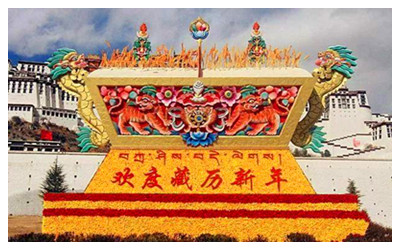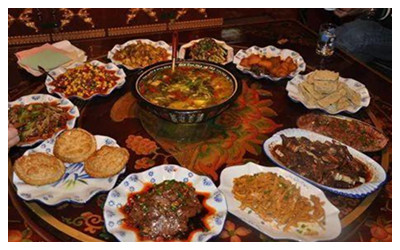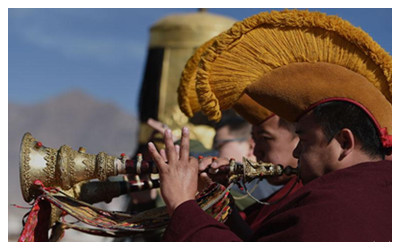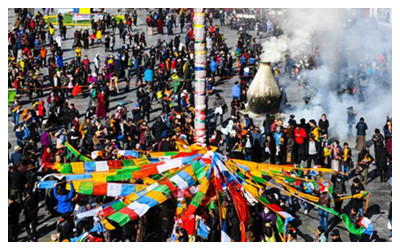Skype: neodalle-travel
Tel: +86 135 7447 2266
E-mail: sales@visitaroundchina.com
 Losar,called by Tibetan people, is Tibetan New Year . Calculated based on the Tibetan calendar. Losar is not one word in the Tibetan language. Actually, it consists of two Tibetan words - “Lo” means new, and “Sar” means year. Losar is the most important traditional festival of the year, and it is also the first Tibetan festival. At that time, each Tibetan family would reunite together to hold a variety of activities to celebrate the arrival of the New Year, which is very lively. As the local people believe in Tibetan Buddhism, many customs of Tibetan Losar are related to Tibetan Buddhism and the festival is permeated with a strong religious atmosphere.
Losar,called by Tibetan people, is Tibetan New Year . Calculated based on the Tibetan calendar. Losar is not one word in the Tibetan language. Actually, it consists of two Tibetan words - “Lo” means new, and “Sar” means year. Losar is the most important traditional festival of the year, and it is also the first Tibetan festival. At that time, each Tibetan family would reunite together to hold a variety of activities to celebrate the arrival of the New Year, which is very lively. As the local people believe in Tibetan Buddhism, many customs of Tibetan Losar are related to Tibetan Buddhism and the festival is permeated with a strong religious atmosphere.Historical Origin of Losar
Dated back to the old times, when there was no Tibetan Buddhism yet, Tibet was controlled by its original religion Bon. The ancient people had a big celebration in winter. They prayed for protection from deities. As time passed, this event was absorbed by Tibetan Buddhism and became an annual festival. In the 13th century, during the reign of the Sakya Dynasty, January 1st was set as the beginning of the new year, which means the King's New Year. From then on, Losar has officially become an important traditional festival in Tibet and continues to this day.
When is Losar Celebrated?
All the Tibetan festivals are based on the Tibetan calendar, so is the Losar. This festival starts from the middle of December in the Tibetan calendar to the 15th day of the first lunar month. The preparatory period is the preparation process. From the first day of the first lunar month to the fifteenth day of the first lunar month is the festival period. And it’s almost as same as the Chinese New Year, in mid-February of the solar calendar. Tibetan calendar counts on 12 or 13 lunar months. So the Tibetan Losar might coincide with Chinese New Year, one day apart, or one month apart, etc. Losar is usually held during February and March when Tibet is closed for foreigners. Thus, international travelers have little chance to see such a big feast in person. However, you could learn it from this post and imagine the alive scene.It starts from the 1st of the first month of the Tibetan lunar calendar and lasts for fifteen days. In 2021, Losar falls on Feb. 12.
Folk Activities of Losar
Same as all the celebrations for a new year in the world, Losar Festival is also a happy time with family together to bid farewell to the old year and usher in the new. Besides, as a minority nationality, nearly every single Tibetan is a good singer or dancer. Follow their own nature, Tibetan people get used to expressing their emotions by singing and dancing. So, if you happen to travel in Tibet during this time, your ear will be fed with festive music all around.
The biggest difference between the Losar and the Chinese New Year is the continuous chanting as Tibet is a religious place where almost all people have faith in Tibetan Buddhism. Tibetan people believe that evil demons exist everywhere. So, at Losar Festival, there is a very important activity for dislodging evil. They dress up in their folk costumes, chant Buddhist scripture and pass fire torches on the street. Expel the evil while praying for good luck and blessing for the coming new year.
Besides the above activities, there is another interesting one, the antimasque. For example, the deer dance, or the funny fight between the king and his subordinates, which can make people laugh out loud. In one world, Losar Festival is a celebration full of music, dance, and joy.
Preparation of Losar
Preparations for the Losar start from mid-December of the previous year. Every family will place the tsampa, fried wheat grains, ghee, and highland barley as sacrifices at home. Also, soak a bowl of highland barley seeds in water to make them grow an inch or two long seedlings in the New Year season. All these were sacrificed in the center of the altar at home to pray for a good harvest in the coming year.
Tibetan people will have a thorough sweep up to make sure everywhere in the house is clean enough, especially the kitchen. It implies to clean away the dirt or the bad luck of the old year and ready to greet the new year. Tibetan people consider the kitchen is the most important part of the house because the food is made there. So, they will pay particular attention to it when cleaning the house, even the chimney will be swept dirtless.
How to celebrate Losar ?
 Tibet New Years's Eve
Tibet New Years's Eve
On Tibet New Year’s Eve, the most fun rituals are to eat "Gutu" noodles and exorcism rituals to greet the Losar. Gutu is a Dough Balls, of which the skin is made of highland barley powder and the filling is various stuff, such as rice, salt, chilies, wool, or coal, etc. Don’t be surprised with the stuffing. They have meanings. The Dough Balls will be handed out after cooked. If someone eats rice or salt in the ball, it’s a good sign to get fortunate in the near future. This is both a kind of divination and entertainment, which makes the whole family happy.
After Gutu Gutu Banquet, there's an exorcism ritual. The male host lights the torch and turns around in every corner of the house, shouting "Get out, get out..." and then throw the torch and the prepared ghost food at the intersection to drive out the year's unsatisfactory and bad luck.
Losar Day 1
 On the first day of the Losar, there will be a "water grab". The housewife needs to carry back the first bucket of water in the New Year. According to Tibetan tradition, the first bucket of water on the first day of the Tibetan calendar is "golden water", and the second bucket of water is called "silver water", which indicates good fortune, luck, and wealth. When the sun rises, the people in costumes have eaten several festive foods in order of aging. At that time, neighbors would go to each other's door by holding "Chema" to bless the others, respect highland barley wine, and recite the long-held "Tashi Del Pin Songcuo" and "Emma Padragong Kangsang", etc. which represent auspiciousness, health, happiness, and harmony. After that, the whole family will gather behind closed doors. On the first day of the New Year, many farmers and herdsmen who believe in Buddhism would also visit the Jokhang Temple in Lhasa to pray for peace and health in the New Year.
On the first day of the Losar, there will be a "water grab". The housewife needs to carry back the first bucket of water in the New Year. According to Tibetan tradition, the first bucket of water on the first day of the Tibetan calendar is "golden water", and the second bucket of water is called "silver water", which indicates good fortune, luck, and wealth. When the sun rises, the people in costumes have eaten several festive foods in order of aging. At that time, neighbors would go to each other's door by holding "Chema" to bless the others, respect highland barley wine, and recite the long-held "Tashi Del Pin Songcuo" and "Emma Padragong Kangsang", etc. which represent auspiciousness, health, happiness, and harmony. After that, the whole family will gather behind closed doors. On the first day of the New Year, many farmers and herdsmen who believe in Buddhism would also visit the Jokhang Temple in Lhasa to pray for peace and health in the New Year.
Losar Day 2
 From the second day of the Losar, friends and relatives began to visit each other for New Year greetings, which lasted three to five days. As soon as the guest and the host meet, they will bless each other "Tashi Delek" and give each other a Khata, and the host will ask the guest to enter the house and sit down. At this time, the host will bring "Chema", and the guest will pinch a little bit of the highland barley and tsampa in Chema and spread it into the air, praying to the heaven, earth, and gods, etc., and then pinch a little more in the mouth. Next, the host will bring highland barley wine and wine bowl, and invite the guests to drink. To show respect for the host, guests should bottom up the drink for the third time. If you can't finish drinking, the hospitable host will entrust relatives and friends to sing to persuade the wine. After singing the toast, the guests must finish the glass of wine. During the Tibetan New Year, in the square or on the open grass, you can also often see Tibetan men and women in costumes gather in a circle to dance the Guozhuang and Xianzi to celebrate the New Year.
From the second day of the Losar, friends and relatives began to visit each other for New Year greetings, which lasted three to five days. As soon as the guest and the host meet, they will bless each other "Tashi Delek" and give each other a Khata, and the host will ask the guest to enter the house and sit down. At this time, the host will bring "Chema", and the guest will pinch a little bit of the highland barley and tsampa in Chema and spread it into the air, praying to the heaven, earth, and gods, etc., and then pinch a little more in the mouth. Next, the host will bring highland barley wine and wine bowl, and invite the guests to drink. To show respect for the host, guests should bottom up the drink for the third time. If you can't finish drinking, the hospitable host will entrust relatives and friends to sing to persuade the wine. After singing the toast, the guests must finish the glass of wine. During the Tibetan New Year, in the square or on the open grass, you can also often see Tibetan men and women in costumes gather in a circle to dance the Guozhuang and Xianzi to celebrate the New Year.
Losar Day 3
On the third day of the Losar, it is called ‘Yosei’ in Tibetan, which means offering sacrifices and prayers at high places. People from Lhasa will go to the roof balcony to simmer mulberries and put new prayer flags on a corner of the roof. The neighbors once again exchange their blessings, respect each other with Chema and barley wine, sing, and dance together on the roof balcony or courtyard. Many people also travel in groups to the front of the Jokhang Temple and the Baoping Mountain in the east and Yaowang Mountain in the west to simmer mulberries, insert prayer flags, and pray for blessing. After the 3-day celebration, the Tibetan Losar will continue to be celebrated until the fifteenth of the first month of the Tibetan calendar.
 Ask Questions ?
Ask Questions ?